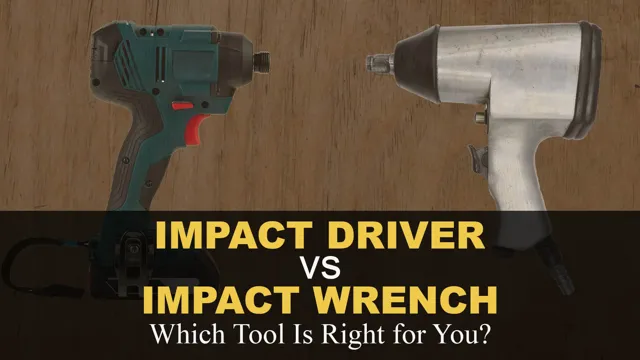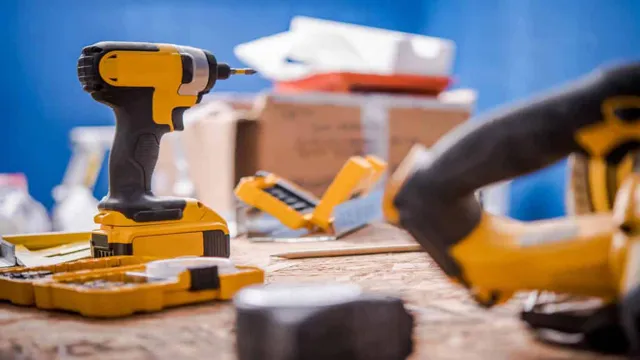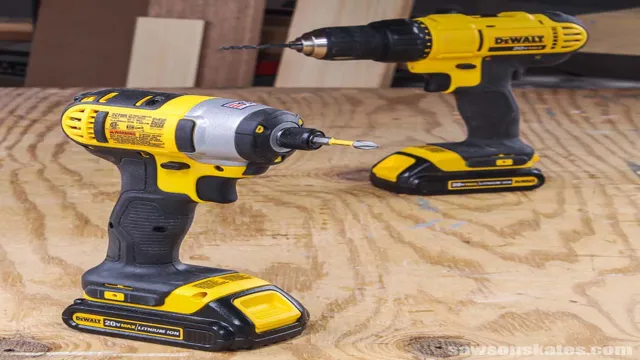How to Take Bit Out of Impact Driver: Quick and Easy Tips

If you’ve ever used an impact driver, you know how handy these powerful tools can be for driving screws and bolts quickly and easily. However, when it comes time to remove a bit from your impact driver, things can get a bit tricky. It’s not always immediately obvious how to do it, and if you’re not careful, you could end up damaging the tool or hurting yourself.
But fear not! Removing a bit from an impact driver is actually not that complicated, as long as you follow a few simple steps. In this blog post, we’ll guide you through the process, giving you all the information you need to safely and easily remove bits from your impact driver. So let’s get started!
What You Will Need
If you’re reading this, I’m guessing you’ve been trying to replace a bit on an impact driver, but you’re not sure how to remove it. Well, the good news is that it’s not too difficult! But first, you’ll need a few things. Make sure you have a replacement bit for your driver, as well as a pair of pliers or a small wrench.
You may also want to have a towel or rag handy to protect your hands and the driver from any scratches. Once you have everything you need, you’re ready to take the bit out and pop in a new one. Don’t worry, it’s a quick and easy process once you get the hang of it!
Impact Driver
If you’re looking to tackle a DIY project that requires you to fasten bolts, screws, and other materials, an impact driver is the perfect tool for the job. To get started, you’ll need an impact driver itself, appropriate driver bits, and a power source for the driver (either batteries or a cord). It’s important to choose the right driver bits for the task at hand, as using the wrong bit can lead to damage or stripped screws.
Make sure to have a variety of sizes and types of bits on hand for different jobs. Additionally, consider investing in a set of impact-rated sockets, which can help with tasks like removing lug nuts on a car. By having the necessary tools readily available, you can make sure that your DIY projects are completed quickly and efficiently with the help of an impact driver.

Safety Gear (Gloves, Glasses)
When it comes to safety gear for construction or DIY projects, gloves and glasses are essential. Gloves protect your hands from cuts, burns, and other injuries while handling tools and materials. They also provide grip and prevent slipping.
Look for gloves that are specific to your task, such as heavy-duty leather gloves for welding or cut-resistant gloves for handling sharp objects. Safety glasses protect your eyes from debris, dust, and other hazards. They come in various styles, including goggles, wraparound glasses, and full-face shields.
Consider the task at hand and choose the appropriate eye protection. The key is to prioritize your safety and choose gear that fits properly and is comfortable to wear for prolonged periods. By investing in the right safety gear, you can prevent accidents and injuries, allowing you to focus on completing your project with peace of mind.
Steps to Remove Bit
Looking to remove a bit from your impact driver but not sure how to do it? Don’t worry, it’s actually a pretty simple process! First, you’ll want to make sure the driver is turned off and unplugged if it’s electric. Then, locate the chuck, which is the part of the driver that holds onto the bit. Depending on your model, you may need to adjust the chuck by hand or with a tool, like a chuck key.
Once it’s loosened, you should be able to manually pull out the bit from the chuck. If it’s particularly stubborn, you can try wiggling it a bit or using pliers to get a better grip. And that’s it! With a little bit of patience, you should have your bit removed in no time.
Step 1: Unplug the Driver
Removing a bit from a drill can be a daunting task, especially if you’re not familiar with the process. The first step in removing a bit is to unplug the driver. This ensures that there is no power source going to the drill and reduces the risk of accidents.
Make sure that the drill is set down on a stable surface and that the bit is in a secure position. This will prevent any unwanted movements that may cause injury. Once the driver is unplugged, you can proceed to remove the bit.
It’s important to note that each drill may have a different bit removal process. Be sure to consult the manual or do some research to ensure a safe and proper removal. By taking the time to properly remove the bit, you’ll save yourself time and frustration in the long run.
Step 2: Loosen the Chuck
Removing a drill bit from a drill requires several steps, and one of them is loosening the chuck. The chuck is the part that holds the bit in place, so loosening it will allow you to remove the bit. Begin by checking if your drill has a keyless or keyed chuck.
Keyless chucks can be loosened by hand, while keyed chucks require a special key to loosen the jaws. For a keyless chuck, turn it counterclockwise to loosen the jaws and release the bit. If you have a keyed chuck, insert the key into the hole and turn it counterclockwise.
Once the chuck is loosened, you should be able to easily remove the bit from the drill. Remember, always wear gloves and eye protection when working with power tools to ensure your safety. By following these simple steps, you can remove the bit from your drill in no time and be ready to tackle your next project.
Step 3: Remove the Bit
Removing a bit can be a tricky job, but with the right tools and technique, it can be done quickly and efficiently. Step 3, remove the bit, is where the real work begins. Use your wrench to turn the chuck counterclockwise until the bit loosens.
Then, carefully pull out the bit and place it in a safe location. It’s important to use caution when removing the bit to avoid any injuries or damage to the tool. Be sure to inspect the removed bit for any signs of wear and tear or damage, and if necessary, replace it with a new one.
With the bit successfully removed, you can move on to the next task at hand with confidence. Remember to always handle your tools with care to ensure they last for years to come.
Tips for Easier Removal
If you’re struggling with how to take the bit out of your impact driver, there are a few simple tips that can make the process much easier. First off, always make sure your impact driver is turned off and unplugged before attempting to remove the bit. Next, use the chuck key or locking mechanism to loosen the chuck and release the bit.
If your impact driver doesn’t have a chuck key or locking mechanism, try using a pair of pliers to grip the bit and turn it counterclockwise to loosen and remove it. Another helpful tip is to apply a small amount of lubricant or oil to the chuck to make it easier to twist and remove the bit. With these simple tips, you’ll be able to remove your impact driver bit with ease and get back to work in no time!
Use a Bigger Chuck
One of the most frustrating things about woodworking is struggling to remove a drill bit from a chuck. It seems like no matter how hard you try, the darn thing just won’t budge! But fear not, there is a simple solution: use a bigger chuck. If you’re trying to remove a bit from a small chuck, it’s likely that the chuck’s jaws aren’t able to grip the bit tightly enough to loosen it.
By using a chuck with larger jaws, you’ll be able to get a better grip on the bit and remove it with ease. Plus, having a larger chuck on hand can also come in handy for those larger projects where you need to use larger bits. So, next time you’re struggling to remove a bit, remember to try a bigger chuck – it’ll make your life so much easier!
Use Lubricant
If you’re having trouble removing something, one trick to make the process easier is to use lubricant. Lubricant can make even the toughest jobs a breeze. Whether you need to remove rusted bolts or a stubborn sticker, adding a little lubricant can make all the difference.
It works by creating a barrier between the two surfaces, reducing friction, and allowing for an easier removal process. One recommended lubricant is WD-40, which can be found at most hardware stores and is great for a variety of tasks. Simply spray it on the area you want to lubricate and let it sit for a few minutes before attempting to remove the object.
With the added aid of lubricant, you’ll find that even the most difficult removal tasks become much simpler.
Conclusion
Well, my dear tool enthusiast, it seems we have arrived at the end of our journey. After mastering the ins and outs of the esteemed impact driver, it’s time to bid adieu. But before we do, let me impart one final tip on how to take a bit out of an impact driver.
First and foremost, make sure the impact driver is turned off and unplugged. Then, locate the release button on the chuck and press it down. With your other hand, gently pull the bit out of the chuck.
Voila! You’ve successfully extracted the bit from your trusty impact driver. It may seem like a small task, but every DIYer knows that attention to detail and proper maintenance of our beloved tools translates to optimal performance and longevity. So, until our paths cross again, remember to keep your impact driver charged and your bits sharp.
Happy building!”
FAQs
1. How do I remove a bit from an impact driver? A: To remove a bit from an impact driver, hold the collar of the chuck and turn it counterclockwise until the bit is released. 2. Can I use any type of bit with an impact driver? A: No, not all bits are compatible with impact drivers. Make sure to use bits that are specifically designed for use with impact drivers. 3. What is the best type of bit to use with an impact driver? A: Generally, impact-rated bits are the best option. These bits are designed to withstand the high torque and vibrations of an impact driver. 4. How do I change out the chuck on my impact driver? A: Changing out the chuck on an impact driver can vary depending on the model. Consult the manufacturer’s instructions for specific steps on how to change the chuck. 5. Can I use an impact driver to drill holes? A: While an impact driver can be used for light drilling, it is not recommended for heavy or precision drilling. A drill is better suited for those tasks. 6. How do I maintain my impact driver bits? A: To maintain your impact driver bits, keep them clean and dry, and store them in a properly labeled container. Replace worn or damaged bits as needed. 7. Can an impact driver be used to remove screws? A: Yes, an impact driver is a great tool for removing screws quickly and easily. Just make sure to use the appropriate bit for the screw type and size.



